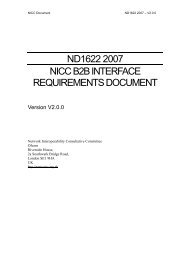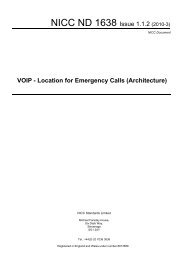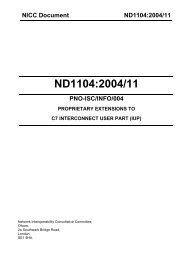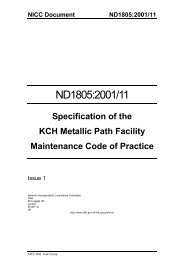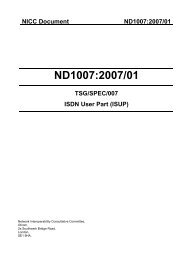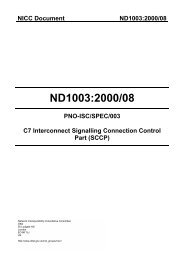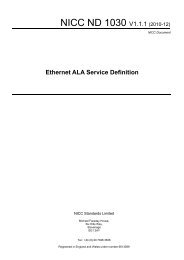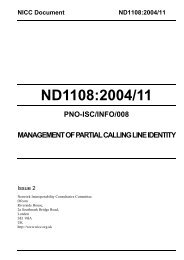âWires-onlyâ VDSL2 Modem Test Plan - NICC
âWires-onlyâ VDSL2 Modem Test Plan - NICC
âWires-onlyâ VDSL2 Modem Test Plan - NICC
You also want an ePaper? Increase the reach of your titles
YUMPU automatically turns print PDFs into web optimized ePapers that Google loves.
48<br />
<strong>NICC</strong> ND 1436 V1.1.2 (2013-09)<br />
3) Set the line simulator to a loop length of 100m of TP-100 cable with noise injection disabled<br />
(i.e. noise free).<br />
4) Ensure that the CPE has attained synchronisation.<br />
5) Capture the upstream PSD and wideband power and compare against Part C of the BT<br />
ANFP [6].<br />
6) Repeat for 500m and 1300m loop lengths.<br />
Note : the KL0 value of each loop length (required to establish the appropriate mask in Part C of<br />
the ANFP) shall be established by measuring the insertion loss of each loop at 1MHz.<br />
Expected Outcome – If the upstream transmit spectrum complies with the spectrum limits defined<br />
in Part C of the BT ANFP [6] over the various loop lengths tested and the upstream transmit power<br />
does not exceed 14.5dBm then this will be deemed a “Pass”, else the result will be a “Fail”.<br />
C.1.3 AELEM<br />
Description – The CPE modem shall support the alternate electrical length estimation methodology<br />
(AELEM) for estimating the electrical length of the connection between the CPE modem and the<br />
DSLAM (mode ELE-M1) as defined in G.993.2 [3].<br />
<strong>Test</strong> Procedure – AELEM is not currently supported on the BT NGA platform therefore it not<br />
possible to perform this testing on Live build level network elements. However, an indication of<br />
how well a CPE modem estimates loop length in the presence of bridged taps caused by internal<br />
wiring in a self-install scenario can be obtained using the following test procedure.<br />
<strong>Test</strong> Description –<br />
1) Configure the DSLAM to implement a CAL value of 30dB and the default band profile.<br />
2) Connect the CPE modem to the DSLAM using the test setup shown in Figure C.3<br />
3) Set the line simulator to a loop length of 500m of TP-100 cable with the appropriate crosstalk<br />
injected at each end of the system. This equates to a kl0 value of ~10dB measured at 1MHz.<br />
4) Ensure that the CPE has attained synchronisation.<br />
7) Wait 2 minutes for the system to stabilise and then record reported kl0 values for each band<br />
(DS1, DS2, DS3, U1, U2 etc.) from EMS.<br />
8) Capture the upstream transmit PSD spectrum.<br />
9) Compare the PSD against the BT ANFP [6] Part C PSD mask for the kl0 value of 10dB.<br />
10) Compare the reported kl0 values for each band with the ranges defined in Table C.2.<br />
11) Repeat this for a 100m loop (kl0 ~ 2dB @ 1MHz).<br />
<strong>NICC</strong> Standards Limited



